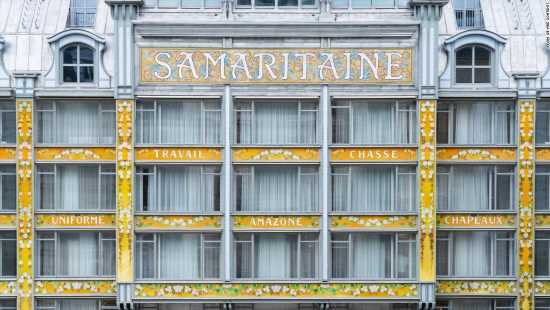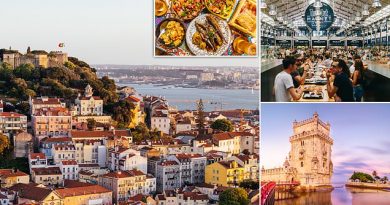La Samaritaine department store: LVMH opens $894 million luxury shopping and tourist destination in Paris
A historic 19th century landmark, forced to fade into the background along the banks of the river Seine in Paris for 16 years, has been brought out of hibernation and resurrected as a new all-in-one shopping, dining and tourist destination.
Part luxury department store, part hotel and promising to feature over a dozen eateries, the €750 million ($894 million) restoration of La Samaritaine, by French luxury conglomerate LVMH, is one of the most anticipated openings of the year in the French capital: On Monday, French President Emmanuel Macron inaugurated the building, calling it a “wonderful French treasure.”
Load Error
When Samaritaine Paris Pont-Neuf opens its doors on Wednesday for the first time since closing in 2005 for safety reasons, it will become the newest luxury department store on the Parisian landscape. While Galeries Lafayette is best known for its theatrical balconies and Neo-byzantine glass dome, and Le Bon Marché bills itself as the world’s oldest continually operating department store, Samaritaine Paris Pont-Neuf’s big draw will be its location.
Set in the geographic center of Paris on the Right Bank, across from the oldest stone bridge in the city, Pont Neuf, the heritage building holds prime real estate along the Seine, with the Louvre museum a short five-minute walk away to the west, the Notre Dame Cathedral within walking distance to the east, and the recently opened contemporary art museum Bourse de Commerce-Pinault Collection five minutes straight north.
Speaking at the opening, Eleonore de Boysson, a regional director for DFS Group, the LVMH-owned luxury retail operator for the store, said the neighborhood “will become a very hyped, born again district.”
Meanwhile, the accompanying five-star hotel, Cheval Blanc Paris, along with its four restaurants and Dior spa, will open later on September 7. All 72 rooms and suites offer views overlooking the Seine, for a price — rates start at 1,500 euros ($1,790).
To restore the landmark to its former glory, LVMH and DFS enlisted top international designs firms including Yabu Pushelberg for the interiors; local agency Malherbe Paris for the basement beauty department, billed as the largest of its kind in Europe at 36,600 square feet; and Japanese firm Sanaa for the somewhat controversial undulating glass façade on Rue de Rivoli, which was slammed by critics for resembling a “shower curtain” when plans were first unveiled in 2011.
But, according to architectural historian Jean-François Cabestan, La Samaritaine has always courted controversy and provoked strong reactions.
“La Samaritaine has always been scandalous,” the co-author of the 2015 book “La Samaritaine, Paris” said during a phone interview.
“From the very beginning, the building was flashy with its colorful enamel paneling and use of glass and iron instead of traditional stone.”
Indeed, in striking contrast to the uniformity of nearby Haussmanian buildings, the signs on the façade of the main entrance at Rue de la Monnaie, designed by Frantz Jourdain and completed in 1910, evoke a Paris of the Art Nouveau era, with classic floral motifs and a vintage color scheme of golden yellow, muted blue-greys, greens and golds.
The façade facing the Seine, meanwhile, is a classic example of Art Deco, designed by Henri Sauvage and completed in 1928. The building is classified as a historic monument in France for being an iconic example of both Art Nouveau and Art Deco design, an architectural rarity, said lead historical monument architect Jean-François Lagneau, who worked on the restoration project over the last 11 years.
“It is truly the most representative building of this confrontation of two styles in Paris, which are normally incompatible,” he told CNN.
But it’s upon entering the main hall, flanked by luxury retail brands Fendi and Balenciaga, that the building’s architectural grandeur reveals itself to visitors: a grand, monumental staircase and five central landing rails in “horizon blue” wrought-iron, lead the eye up to unobstructed views of the soaring glass roof. A trip to the top floor’s Voyager restaurant also rewards visitors with 4,575 square feet of masterfully restored peacock frescoes — a classic Art Nouveau motif — originally painted by Jourdain’s son Francis.
Overall, the result is a bright, airy, luminous space that replicates a clear sky. Or, as Cabestan described it, “a cathedral of color, glass and natural light.”
French writer Émile Zola used similar language to describe the fictional department store setting he invented for his 1883 book “The Ladies’ Paradise” with the help of his writer and architect friend Jourdain who provided conceptual sketches. The department store was a bazaar that replaced churches, he wrote, and became the Parisian woman’s new religion.
Neither Zola nor Jourdain knew at the time that, a few years following the book’s publication, businessman Ernest Cognacq would ask Jourdain to help him expand the retail store he had opened in 1870 at Pont Neuf, called La Samaritaine, into the city’s biggest shopping destination.
In its early 20th century heyday, the department store spanned four stores and took up an entire city block to become the biggest in Paris at 538,200 square feet, attracting a working and middle class clientele for its affordable prices and variety of goods. Today, the restoration of the main department store overlooking the Seine is the smallest and, perhaps most selective among its competition, with a floor space of 215,280 square feet. Overall, the store is home to 600 brands, 50 of which will be exclusive to Samaritaine Paris Pont-Neuf.
“I’m proud that we were able to restore the building as Ernest Cognacq and his architect Frantz Jourdain knew it, and I think they’d recognize their building if they saw it now,” Lagneau said.
Though Cabestan applauds the painstaking restoration efforts and the mixed-use concept — the project also includes social housing, offices and a daycare — he points out that the remake stands in stark contrast to the store’s original heritage as a retailer for the average Parisian: it was a place to go for affordable goods and even to be entertained with in-store theatrical and musical performances.
“In a way, it was an opera house for the poor,” he said. “But this is not a shop for the lower class anymore. This will be for tourists and for people with means.”
Source: Read Full Article




